This post may contain affiliate links. Please read my disclosure policy.
All of the new ingredients you come across on the AIP Diet can be confusing – but don't let AIP flours be intimidating! Here's a detailed guide about the main 5 flours you'll come across.
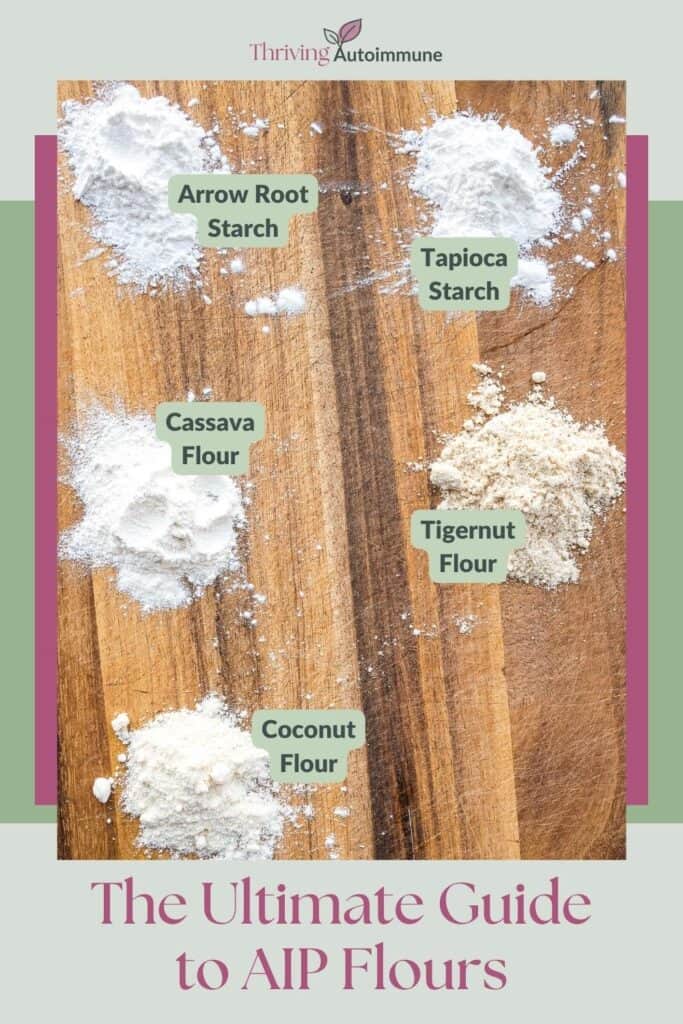
Table of contents
The Main 5 AIP Flours
There are 5 main AIP flours that most recipe developers and bloggers use. These flours are typically used because they are usually more readily available, work well in a variety of recipe types, and can be tolerated by a large amount of people doing the AIP diet.
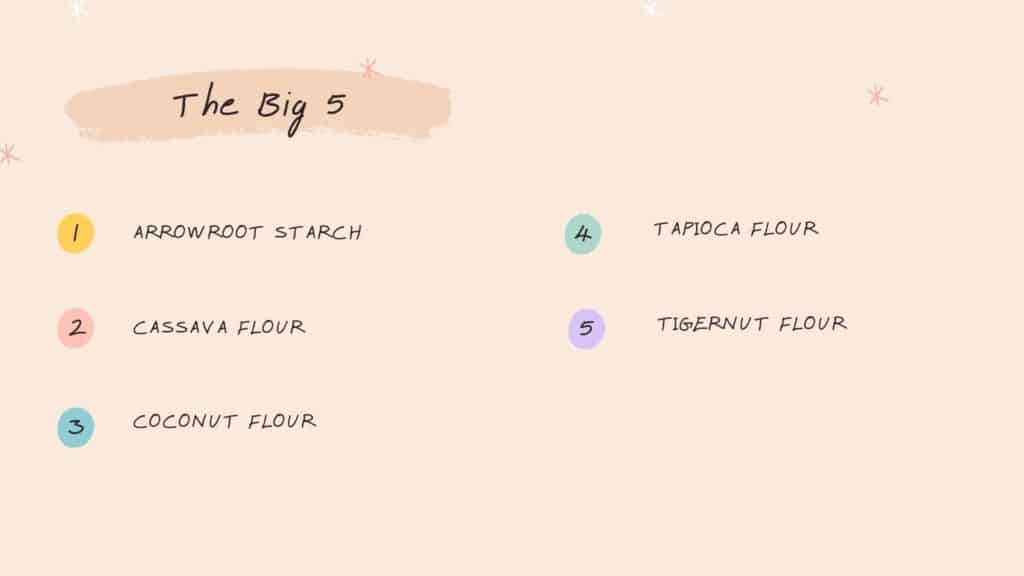
These flours are:
• arrowroot starch
• cassava flour
• coconut flour
• tapioca starch
• tigernut flour
Read each section below to find out more, or if you're more of a visual person, watch the video instead!
Arrowroot Starch
The first flour is arrowroot starch.
Other names for arrowroot
This is known as arrowroot powder, arrowroot starch, and arrowroot flour, and sometimes just plain arrowroot – but they’re all the same thing.
What does arrowroot starch look like?
It’s a fine white powder that is very light and kind of sticky when you rub it together between your fingers.
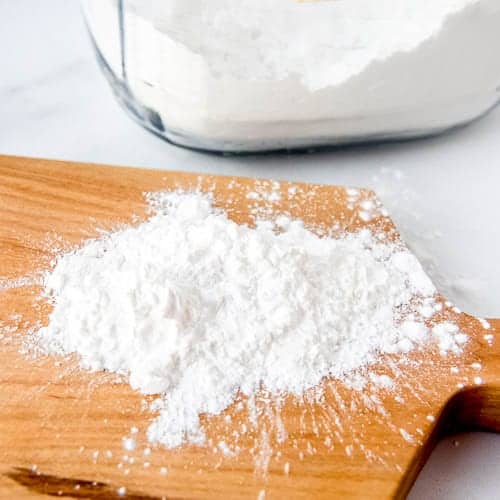
What is it made from?
Arrowroot starch is harvested from a tropical plant called the maranta arundinacea. It's just the starch that has been extracted from the root of the plant, dried, and ground into a powder.
Does it have a flavor?
Arrowroot powder is a pretty mild, bland flour that doesn’t impart any particular taste or flavor into your recipes.
Uses for arrowroot powder
• Thickening – It can be used to thicken gravies, stews, and sauces and is a great substitution for corn starch in recipes for dishes like this.
If you do go about replacing corn starch in a favorite recipe though, start with about ½ of the amount and go up from there, because it can be pretty gloppy if you get too much.
A good practice is to make a slurry by mixing some water, milk, or a small amount of the liquid you’re going to thicken in a separate bowl with the arrowroot, then pour this slurry into the thing you’re trying to thicken and mixing. This will help prevent clumps of arrowroot which are not very pleasant to eat and clumps don’t wind up thickening the sauce.
I also find that the mixture needs to get hot before it really thickens, so make sure to do this over the stove – however, don’t leave it on for longer than a few minutes as it’ll break down again. So like a minute or two right before taking it off the stove works great.
It also can survive a freeze-thaw cycle, unlike cornstarch,so it’s great for things you’ll be freezing after cooking and then reheating.
• Crisping – Because it’s a straight starch, it can help things crisp up. One example of this is sweet potato fries – before putting your homemade sweet potato fries in the oven, toss them with about a tablespoon of arrowroot powder – and your fat of choice, sea salt and any seasonings and they’ll crisp up a lot nicer than without.
It can also help crisp up proteins, like as a crispy coating on chicken. You can just dip the chicken into the arrowroot starch with salt and seasonings before pan-frying. My recipe for Fried Chicken Burgers uses this technique. It calls for tapioca starch but arrowroot can be a good substitute (more on that in a bit).
• In baked goods – You’ll often find arrowroot combined with other flours in baked goods because it doesn’t work so well as a straight starch on its own, but combined with fibrous and protein-filled flours it can really shine.
Substitutions for Arrowroot Starch (and vice versa)
It is NOT a good substitute for wheat flour in regular baked good though as it’s all starch and doesn’t have the same qualities.
However, as for that substitution with tapioca starch that I mentioned, tapioca starch is a very similar starch to arrowroot so they are often used as a substitute for one another. They can be used 1:1 for each other in recipes, so if you have an intolerance to tapioca, arrowroot can be a good choice.
Differences between brands
LOW
When it comes to whether there are difference between the quality, consistency, etc between brands, I don’t find much. The brands all seem to pretty similar, so just get whatever you can find.
Where to buy arrowroot
Typically arrowroot starch can be found in the baking aisles in most stores these days, sometimes in the “alternative” flours section. Otherwise you should be able to find it online. There isn’t much difference between brands, so get whatever one you happen to see (and is a good price).
Can you make your own?
I couldn’t really find many recipes on making your own arrowroot powder, and it looks like it might be difficult getting it to the same powdery consistency as store-bought. Because it’s not overly expensive and pretty easy to find I just recommend buying it.
Cassava Flour
The second main AIP flour, cassava flour, has become quite a popular grain-free flour in recent years. Though in more tropical locales like South America, Asia, and Africa it’s been a staple for a long time.
Other names for cassava
Cassava flour is made from the root of the cassava plant – which is also known as yuca, manioc, Manihot esculenta, mandioca.
What does cassava flour look like?
Cassava flour is a soft, light tan or cream-colored, high fiber flour that’s heavier than the starches like arrowroot and tapioca starch.
Does it have a flavor?
Cassava flour has a bit of a nutty, almost earthy flavor.
You can often taste this in your finished dishes, so keep that in mind. I personally think it’s a bit of an acquired taste – I didn’t like it so much at first but now I love it.
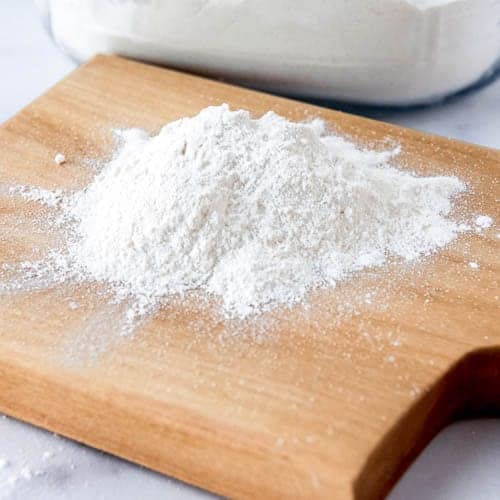
What it's made from
The flour is made by peeling, drying, and grounding the cassava root.
Substitutions for cassava flour (and vice versa)
I often get the question of whether you can just use tapioca flour instead of cassava flour in recipes, and the answer is NO. Cassava flour is the whole root of the cassava plant, tapioca is JUST the starch extracted from the cassava root. Therefore they act completely differently when used in certain recipes and cannot be uses to substitute for each other.
It’s the most like wheat flour out of the AIP flours and in fact can be used 1:1 for wheat flour in many recipes. I, however, find this to be a little less consistent with the AIP and Vegan sorts of recipes that don’t use eggs for binders.
Uses
Cassava flour is one of the only AIP flours that can successfully be used on its own without other flours and starches.
Therefore uses include all manner of baked goods, tortillas, pasta, pancakes, waffles, pizza crusts, pies, and raw things like edible cookie dough.
Basically many of the things you’d typically find made with wheat flour, you can find made with cassava flour.
Try: AIP Cassava Flour Pancakes
Additional info on cassava flour
• Can be gummy – Often cassava flour baked goods (and this is also true with the arrowroot and tapioca baked goods as well) can be a little gummy when done. This is normal, but takes a lot of people off guard when they aren’t expecting it. This can be an advantage when making some dishes that you want a “melted cheese” like texture though!
• High in carbs – Cassava is also high in carbohydrates, so it is a good candidate for moderation in your diet. Don’t just replace a diet of wheat flour-based baked goods, pastas and tortillas every day with cassava flour alternatives. This won’t help your healing and may just cause you to have blood sugar issues and cravings for a lot longer than you need.
• So many products! – That all being said, it does make some AMAZING AIP alternatives, some of which are quite exciting, like Lovebird cereal, Jovial’s Cassava flour pastas, and recipes like my AIP Flatbreads, Cassava Flour Pancakes, Downshiftology’s cassava flour tortillas, and so much more.
Differences between brands
HIGH
I’ve noticed that as more and more brands start making cassava flour that the actual end product tends to be pretty inconsistent. I don’t know if they’re all using different processes to create the flour or what, but it can be quite frustrating (and expensive) when you try to make a cassava flour recipe and it doesn’t come out.
Therefore, if a blogger or recipe specifically mentions a brand, it’s best if you can use that particular brand. This isn’t to say it won’t come out if you use another one, but the chances are higher if you don’t use the one they tested with.
Where to buy cassava flour
It may be a bit harder to find cassava flour in stores – natural foods stores like Whole Foods, Natural Grocers, and Sprouts may have them in their baking sections, but many mainstream stores may not.
It is becoming more prevalent though. You should be able to find it online, however, and sometimes in Asian or ethnic markets.
Can you make your own cassava flour?
You CAN make your own cassava flour if you wish by first boiling the root, then drying it in a dehydrator or oven and then grinding it down into a flour. Here's a recipe by Predominately Paleo if you’d like to give it a try.
Coconut Flour
The third main AIP flour is coconut flour.
What does coconut flour look like?
Coconut flour is a cream-colored, often clumpy powder that’s a lot more gritty than the powdery starches.
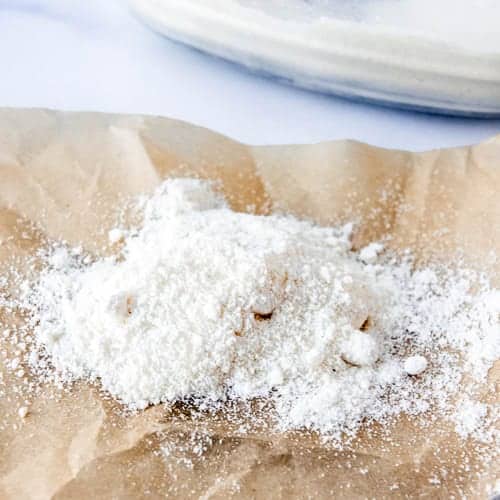
Does it have a flavor?
It sometimes can have some coconut flavor, but it’s usually not that noticeable, especially if you use it with other flavors in a recipe.
You’ll find you may taste it more in a recipe made with all coconut flour than in one with just a few tablespoons of it.
Substitutions for coconut flour (and vice versa)
Coconut flour is the completely unlike wheat flour and acts differently than most other flours when used in recipes.
This means it cannot be substituted for any other flour, nor any flour for it, unless used in a very few specific scenarios, like “breading” a chicken.
But because it soaks up any liquid used in a recipe it (a) needs a lot of liquid to work and (b) doesn’t work like cassava flour, wheat flour, almond flour, or any of the other grain-free or gluten-free flours.
Uses for coconut flour
• Baking – Coconut flour often is mixed with other flours in baked goods like cakes, muffins, and cookies.It can also make some bread-like products.
Usually in baking you’ll find you only need a few tablespoons of coconut flour. However, some recipes use a majority of coconut flour as well- but those typically will be more of a Paleo recipe (and not AIP) as they usually need lots of eggs to work well.
That all being said, you only typically need ¼ of what you’d use in a regular wheat flour-based recipe, which is good since coconut flour can be expensive. And as I mentioned earlier, it usually needs a lot of liquid to avoid being extremely dry. This often causes the end product of a primarily-coconut flour baked good to be a bit spongier than baked goods made with cassava flour or wheat flour.
However, some recipes don’t use liquids and still work (like my AIP Lavender Shortbread cookies for example).
• Breading Proteins: You can also use coconut flour for breading proteins and it works rather well for this, though it doesn’t get as crispy as arrowroot or tapioca starch. It’s more like wheat flour in this situation.
Try: Sheet Pan Coconut Chicken
Additional Info
• Coconut flour is a high fiber flour with some protein as well. This is important to note as the type of fiber is a prebiotic fiber called inulin fiber. Prebiotics are great for you and feed your gut bacteria, but sometimes this can cause a negative reaction in some people with off-balance gut flora. Reactions include gas, bloating, and sometimes other GI symptoms after eating something made with coconut flour – or any coconut products.
If this is you, either avoid coconut flour or only use small amounts and see if you can work your way up to more as you heal your gut and restore a beneficial balance of gut flora.
• Tricky to use – Because of the tricky nature of this flour, I do not recommend experimenting with coconut flour on your own until you’ve had quite a few tried-and-true coconut flour recipes first. Get to understand the liquid to flour ratios, what the recipe developer used to make it work, what the texture of the finished products usually are like, etc first, THEN try stuff on your own if you want.
• Sift it before use – It is a good idea when using coconut flour to sift it as clumps are pretty common and they do not taste good in a finished product.
• Batter can be thick – The batters of primarily-coconut flour-based baked goods may be a lot thicker than you are used to. This is normal. You may need to spoon the batter into muffin cups or onto a skillet instead of pouring. Also, many recipes will call for letting the batter sit at room temperature for at least 10 minutes to let the liquids absorb. Do not skip this step if it calls for it as the item may not cook properly.
Differences between brands
LOW
As for a difference in brands, I’ve used quite a few brands of coconut flour, plus also made my own, and I don’t find a huge difference between them. So unlike cassava flour, you should be fine with any brand.
However, I do caution you to find brands that are sustainably sourced and use Fair Trade practices as the more coconut products gain popularity, the more there are some unscrupulous sources out there that take advantage of farmers, land, and even forcing monkeys to pick the coconuts. So it pays to do your research to make sure you’re not supporting that.
Where to buy coconut flour
I’ve found it pretty easy to find coconut flour in stores these days – natural markets like Whole Foods, Natural Grocers, and Sprouts almost always have it, but I’ve also seen it in many mainstream markets as well. It’s usually in the “alternative” flour sections of baking aisles there. You can find it at Asian and ethnic markets and online as well.
Can you make your own coconut flour?
Yes! You can also make your own coconut flour, which does help to cut down on the expense, by drying the pulp leftover from making homemade coconut milk.
Just dry the leftover pulp in a dehydrator or an oven at low heat until completely dry, then blend with a blender or food processor into a fine powder.
Tapioca Starch
The fourth main AIP flour is Tapioca Starch.
Other Names for Tapioca Starch
It is also called tapioca flour, tapioca powder, and just tapioca. These are NOT to be confused with tapioca pearls, bubbles, flakes, or sticks, which are a different form of this starch.
What does tapioca starch look like?
Tapioca flour is very similar in appearence to arrowroot starch – they’re both light, fine white powders that tend to go poof, up into a cloud, when poured or handled roughly. So I recommend gently pouring any tapioca flours into your recipes with care or else you can end up covered in the stuff!
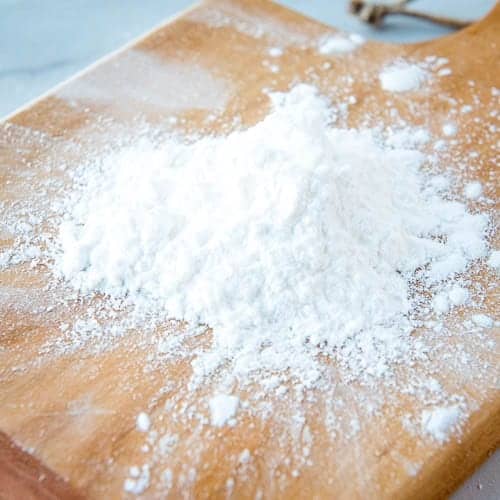
Does it have a flavor?
Not really, like arrowroot powder tapioca starch is a relatively mild powder. Some people can taste it but I think for the most part it is flavorless.
What is tapioca starch made from?
Like cassava flour, it is also made from the root of the Cassava plant.
Unlike cassava flour, which is made up from the entire ground up cassava root, tapioca is made by washing, pulping, and pressing the cassava root. The liquid pressed from the pulp is then evaporated, leaving only the dried starch behind. This is the tapioca starch.
Substitutions for tapioca starch (and vice versa)
As i mentioned in the cassava flour section, tapioca starch and cassava flour can NOT be substituted for each other, nor can you simply just replace the amount of cassava flour in a recipe with more tapioca flour. This will just not work.
HOWEVER – sometimes if you go to an Asian market or ethnic market you may find something marked as tapioca starch or flour that is actually cassava flour. I admit, it’s all very confusing. It’s best if you’re making a lot of recipes to make sure you’re getting the right thing, which may mean buying from more mainstream markets if possible. But in either case, if it’s super snow white and really really fine, it’s probably the tapioca starch we’re talking about in this section. If it’s a creamier/light tan color, it’s probably cassava flour.
Like I mentioned in the arrowroot powder section, it can usually be substituted for arrowroot at a ratio of 1:1 in many recipes.
Uses for tapioca starch
• Crisping the outside of proteins when frying – Tapioca starch can be used similarly to arrowroot powder, but I prefer tapioca over arrowroot for crisping things like a fried crust on a chicken breast as it seems to work better for this.
• Crisping pie crusts and giving a light airy quality to baked goods – It can help crisp up pie crusts and other baked goods but also you’ll often find tapioca starch in baking and bread recipes alongside other flours to help give it a chewy and light quality. Trust me, before we figured out how to do that a few years ago, things were a LOT denser. Plus it also helps to prevent the baked goods from becoming soggy after baking.
Try: AIP Lemon Scones
• Thickening – It can also thicken gravies, stews, and sauces, however I find arrowroot to be better at this. But like arrowroot powder, if you’re going to add it to these things to thicken them, do so by making a slurry first.
Also like arrowroot starch it also can withstand a freeze-thaw cycle, so if you cook something, freeze it and then reheat it, it should still retain the thickness.
• As a binder – It also can be used as a binder in place of wheat flour in ground meat products, like meatballs.
• Dairy-free “cheese” – And because it gelatinizes so well when heated with a liquid it makes a good dairy-free cheese. Here's a great AIP tapioca cheese recipe by The Curious Coconut.
Additional Info
• Just like cassava flour, it’s pretty much 100% carbohydrate, so just be mindful of your consumption of it so that you don’t overdo it. It also doesn’t really have much in the way of nutrition either, so again, just be mindful.
Differences between brands
LOW
Unlike cassava flour, tapioca starch seems to be pretty consistent across brands, so I wouldn’t worry too much about that.
Where to buy tapioca starch
Typically tapioca starch can be found in the baking aisles in most stores these days, sometimes in the “alternative” flours section. It also can be found at Asian and other ethnic markets. Otherwise you should be able to find it online.
Can you make your own tapioca starch?
Extracting the starch from the cassava root is an involved process, so I don’t recommend doing it on your own unless you're really motivated. However you can make flour from tapioca pearls if you’re in a pinch.
Tigernut Flour
A relative newcomer to the gluten- and grain-free world, the last main AIP flour, tigernut flour, has also been seeing a lot more popularity these days.
Other names for tigernuts
Tigernuts are not as well known in the US as in other parts of the world, where they're called things like chufa, groundnuts, yellow nutsedge, and earth almonds.
What does it look like?
Tigernut flour is a light brown, slightly grainy flour.
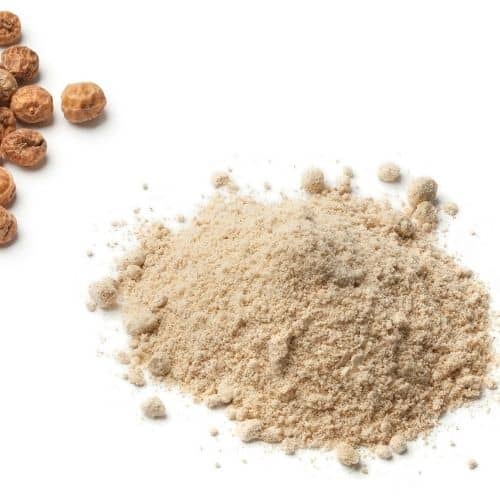
Does it have a flavor?
The flavor of tigernut flour is slightly sweet and slightly nutty.
Because of the sweet flavor, it’s more suited for sweeter things rather than savory ones since the flavor does come through.
What tigernut flour is made from
The flour is made typically from grinding whole tigernuts, but also can be made from the dried pulp leftover from tigernut milk.
Tigernuts, despite the very confusing name, are not nuts. They’re small tubers – root vegetables, sort of like sweet potatoes. Because they’re not nuts, they make a great flour for those with nut sensitiviies, allergies, and anyone on a nut-free diet like AIP.
Substitutions for tigernut flour (and vice versa)
Tigernut flour is not a good substitute for wheat flour in most recipes, so I wouldn’t even bother trying it with your favorite non-AIP recipes.
It CAN be used as a substitute for cassava flour in some recipes, as well as almond flour in some Paleo and grain-free recipes, but not all.
Again – just like coconut flour I recommend you try a few tigernut recipes first to learn what the texture is like and how the recipe developer uses it before trying it on your own.
Uses for tigernut flour
Tigernut flour is a pretty dry flour and doesn’t absorb liquids very well, so it typically is used with other flours, especially the starchier ones, to keep things from crumbling.
As a result, it’s best used in baked goods and bread-like things like crepes and also cookies, pancakes, and waffles.
It also can be used raw in things like my 30-second tigernut butter, which is a great AIP-friendly nut-butter substitute!
Also, as I mentioned above, because of the sweet flavor it’s more suited for sweeter things rather than savory ones since the flavor does come through.
Additional Info
• High in protein and fiber – Like coconut flour, tigernut flour is high in protein and fiber so it can cause gas and bloating if your gut flora is in imbalance. So watch out for that and eat in moderation or omit it if necessary until your gut heals.
However, I’ve found that many who have issues with coconut can tolerate tigernuts better, so if you do have issues with coconut flour, try a small amount of tigernut flour first to see what happens.
• Can be grainy – It can sometimes be grainy, especially if it’s not cooked, so keep that in mind if using it in raw applications. You can sift it to help with this.
Differences in between brands
LOW
I haven’t found much of a difference between brands, so I don’t think at the moment you need to worry about this much.
Where to buy tigernut flour
Tigernut flour is the only flour on this main list of five main AIP flours that I have never found in a local store and have only gotten online.
ShopAIP and Amazon have usually been where I get it – and as I mentioned before, I saw that Thrive Market is now selling a version under their own brand.
I hope that as it gains popularity as a grain-free, nut-free flour that it’ll be more readily available in stores!
Can you make your own tigernut flour?
Yes! There are two main ways:
• From leftover milk pulp– You can make your own tigernut flour by taking the leftover pulp from homemade tigernut milk and dehydrating or drying it at a low temperature in your oven until dry (like 4-6 hours). Then put it in a blender or food processor and blend until it’s a powder.
It probably won’t get as fine as store-bought tigernut flour, but will still work great and you get both tigernut milk AND tigernut flour from one batch of tigernuts. This version of tigernut flour is higher in fiber and lower in carbs than tigernut flour made from whole nuts, so do take that into account if you have any sort of gas, bloating, or GI distress after.
• From whole tigernuts – You can also blend whole tigernuts to make flour, but you need a high-speed powerful blender to do this to make sure you’ll get a fine flour and not just a coarse meal. I find it just easier to buy flour due to the issues with consistency in making tigernut flour this way, plus I don’t think it’s any cheaper than buying pre-made flour. But you CAN make it this way if you choose.
Other Specialty AIP Flours
Aside from the main top 5 AIP flours, there are a number of specialty flours. They are typically harder to find and can be quite expensive, depending on what it is, so many recipe developers avoid using them because they aren’t as available and are harder to source. Some are becoming more easily found though, so they may become more popular as time goes on.
Some of these more specialty flours include:
•cricket flour
• green banana flour
• plantain flour
• pumpkin flour
• squash flour
• sweet potato flour
• taro flour
• water chestnut flour
I’m not going to go into how to use each of these, partially because, to be honest, I’m not even sure how for most of them. I’ve made a few recipes with them but nothing I’ve been overly impressed with, so I’ve stuck with the main 5 flours and it seems that most recipe developers do as well as there are very few recipes out there for these other flours.
One note I have for cricket flour, which is a high protein flour popular with athletes is that apparently some of them are fed diets of corn and wheat, so this may or may not affect you. If you want a funny video, check out Stacy at Real World AIP’s video where she tried to make her own cricket flour. Not something she (nor I) suggest.
Summary
I hope this helps you get a better grasp on the basics of the main 5 AIP flours, what they can be used for, and any other information that might be helpful or relevant!


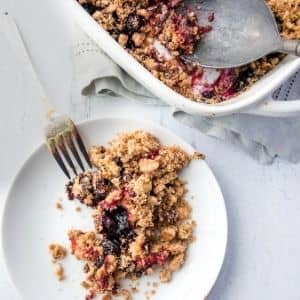


Hey Michele!
I just wanted to say thanks so much for taking the time to inform people(me!) about the very useful things in this article, I do appreciate it and there were a couple of these flours that I am recently new to and your article taught me a lot about what to expect, how their properties work, etc… Thank-you!
If tigernut can sometimes be substituted for cassava, does that mean cassava could be substituted for tigernut flour? I found I have an intolerances for both coconut & tigernut flours on AIP (elimination) and finding it difficult (with other foods intolerance that I have) to come up with some things to try so I don’t get bored while my gut heals.
Eh, it really depends on the recipe and many times cassava flour would be too starchy to replace tigernut flour. But sometimes it would be fine. I’d just look for recipes that don’t use tigernut flour though as there are plenty out there.
Thank you for this! Very useful info!
Thanks!!!